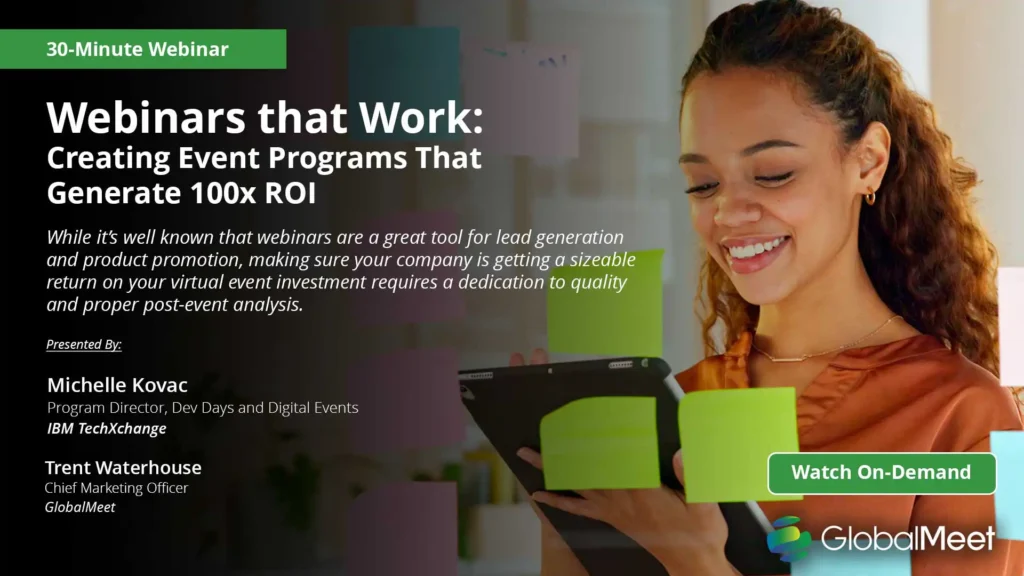
Powering Connection: Hybrid Strategies for Industry Conferences and Risk Management Summits
- by GlobalMeet Blog Team
- ,
Industry conferences and risk management summits have long served as essential forums for thought leadership, networking, and knowledge exchange. As the events landscape continues to evolve hybrid events that combine in-person and virtual participation are emerging as the dominant model for the modern conference sphere. These events offer greater accessibility, flexibility, and audience reach, making them perfect for sectors that value both accessibility and security.
However, hybrid events also bring organizational challenges, requiring careful planning, technical integration, and engagement strategies that cater to diverse attendee needs. With the rise of hybrid events in industry conferences it is key to balance innovation with practicality and attendee satisfaction.
The Role of Hybrid Events
Hybrid events are rapidly changing the way that professional conferences and summits are planned and executed. Without the limitations imposed by venue capacity and geographic location hybrid conferences are enabling global participation without compromising attendee experience.
In industries where the speed of information exchange is critical, hybrid events allow stakeholders from all regions to participate in real time, limiting potential miscommunication and allowing for key messages to transmit at the perfect moment. The broad scope of hybrid events facilitates rapid responses in critical moments, without compromising regulatory compliance.
By adopting a hybrid approach, event organizers can extend the lifespan of their content, enabling sessions to be recorded, replayed, and repurposed as many times as required. This not only saves time for key internal teams, but creates additional value for both stakeholders and participants.
Balancing Experiences for Maximum Impact
One of the main challenges in a hybrid event strategy is creating an experience that feels equal for both in-person and virtual attendees. A successful hybrid conference shouldn’t feel like two separate events, but one cohesive experience delivered across multiple platforms.
Content Availability
When considering the balance of in-person and virtual elements it is important to ensure that all content is available to all attendees. Keynotes, panels, discussion groups, and breakouts, should all be accessible through livestream or on-demand video as well as happening in person.
Consistent Branding
While it won’t be possible to deliver identical experiences, ensuring that branding and messaging are consistent across both in-person and virtual spaces creates a sense of unity for attendees.
Good Moderation
For attendees accessing the event through a virtual portal, strong moderation of sessions can make or break their experience. Dedicated moderators should be assigned to both in-person and virtual spaces to both encourage participation and troubleshoot any issues that may arise.
Networking Opportunities
Digital networking may not have the same allure as the traditional coffee table chat, but that doesn’t mean that it shouldn’t be arranged for virtual attendees. Organizers can make use of matchmaking tools, live chat, and virtual breakout spaces to connect remote attendees with each other, and with on-site participants.
Consider Your Audience
It is important to remember that each attendee will have different expectations from the event. In-person attendees may look for face-to-face interaction opportunities and hands-on experiences, while virtual participants are likely to value flexibility and succinct content delivery. Designing hybrid conferences with these preferences in mind an increase attendee engagement in all areas.
Tools for Seamless Hybrid Event Execution
Good technology is the foundation of a successful hybrid event. The right tools not only ensure flawless execution, but enable seamless communication and content delivery to all audiences. By selecting an enterprise grade hybrid event platform you can ensure a smooth user experience from start to finish.
When choosing an event platform there are several considerations that need to be made.
- Audio Visual Infrastructure: Does the platform have dedicated A/V specialists to ensure seamless broadcasting and onsite production?
- Interactive Integrations: Does the platform feature or integrate with tools that create an immersive and interactive experience for virtual attendees?
- CRM and Analytics: Does the platform have CRM and Analytics capabilities that allow you to analyze audience engagement to maximize follow-ups?
- Security and Compliance: Does the platform boast enterprise-grade security that will ensure attendee data won’t be compromised so you stay compliant?
By using a platform with an integrated toolset that allows you to customize the elements that matter, event execution and outcomes will be dramatically improved, as will attendee experience.
Engaging Attendees Online and In-Person
One of the most complex challenges that hybrid event organizers face is keeping attendees engaged. Even content that is the same at face value will need to be delivered in unique ways for each audience type, with elements to bridge them together wherever possible.
Virtual Attendees
- Try and keep content broken down into smaller segments. This will reduce screen fatigue and help attendees to maintain focus.
- Offer a range of both Live and on demand sessions to cater to multiple time zones and add flexibility.
- Make use of gamification elements such as quizzes to boost engagement.
- Create dedicated virtual networking spaces to create a sense of community.
In-Person Attendees
- Offer exclusive live access to on-site sessions that are being recorded for on-demand viewing by online attendees.
- Incorporate in-room interactive elements such as Q&A and audience polling.
- Consider using an event app to help on-site attendees navigate and plan their day.
Bridging the Gap
- Run hybrid discussion panels, with some speakers in person and some virtual, and an audience made up of both.
- Facilitate virtual networking both before and after the event to connect attendee groups.
- Create a universal event hashtag that can be used by all attendees to create social buzz and conversation.
No matter what engagement strategies you choose, it is vital that they are flexible and can evolve with the needs and expectations of each audience type. Ensuring that every attendee feels involved and valued is the best way to transform one-time passive viewers into regularly attending active participants.
Challenges and Considerations
While hybrid events offer significant potential, they are not without their challenges in set-up and execution. A hybrid conference may occur higher costs in some areas than a traditional event due to the additional audio/visual support requirement. There may also be technical difficulties to overcome that would not impact traditional events such as reliable high speed internet connectivity.
When coordinating schedules and timings it is important to consider both audiences in any plan. Creating a running agenda that works for everyone may require some items being available multiple times, or items being split into multiple sections to reduce screen fatigue, while ensuring that in-person attendees aren’t short of options.
There are also security challenges that must be considered at every stage of the hybrid event process. Choosing a platform that does not offer the right security protection could significantly impact the safety of your customer data, and as a result your entire event.
Knowing the challenges that your event may face early allows them to be considered in every facet of event planning, which in the long run will lead to a smoother event execution.
Conclusion
Hybrid events, with their increased opportunities for reach and resilience, are now a staple for many conferences and industry summits. By investing in the right technology to ensure longevity, prioritizing connection over convenience, and embracing the unique split format, organizations can maintain a leading edge in a competitive events landscape.


